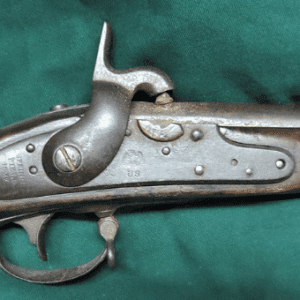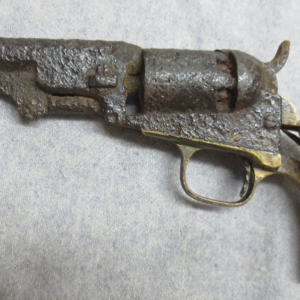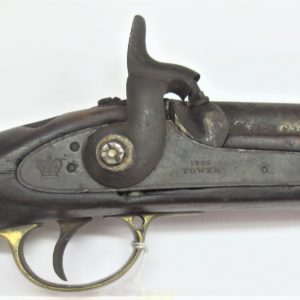Description
Really early example of the weapon known as the Starr DA, this old warhorse is a .44 caliber handgun serial number 2211 (first year production). Most all of the examples in this serial number range were issued to the 11th Illinois cavalry, according to Springfield Research Service.
The Starr revolver was a revolutionary design and well ahead of its time. Named after its inventor, Ebanezer Townsend Starr, the Starr percussion revolver featured a unique trigger which, unlike the double action revolvers designed much later, only served to rotate the cylinder and cock the hammer. Once this was accomplished, the trigger pressed a second actuator located at the rear of the trigger guard – thereby cocking and firing the revolver with a single pull of the trigger. The 1858 Starr revolver features a two piece steel frame held together by a knurled thumb screw located on the right side of the frame. The double action design, though uncommon for its era, first saw use in the American Civil War.
This example is marked with the serial number on the grip frame and under the forward frame and the grips are made of western mule deer horn! It surfaced in an estate sale near Lubbock, Texas and likely went westward after the Civil War. Frame markings are weak but visible. The cylinder rotates freely but, as with most Starr DA’s, the action is stiff and needs tuning. The cylinder only partially rotates in the DA mode and at times the hammer will not engage properly–all common problems with the model (which led to the introduction of a Single Action M1858 later in the War). What stories the old veteran could likely tell!
The 11th Regiment Illinois Volunteer Cavalry served in the Union Army and was raised by orator Robert Green Ingersoll, who became its first colonel, and Basile D. Weeks. The unit began forming into service at Peoria, Illinois in October, 1861 and served until September 30, 1865. Recruits commenced going into camp at Camp Lyon, Peoria, about Nov. 1, 1861. Twelve full companies were recruited and mustered into the United States service by Capt. C.B. Watson of the Fourteenth U.S. Infantry, mustering officer, on Dec. 20, 1861, when they were mounted. They remained at Camp Lyon until Feb. 22, 1862, when they broke camp and marched to Benton Barracks, Missouri where they arrived March 3 and were shortly after armed with revolvers and sabres, with only one section receiving carbines.
On March 25 the first Battalion, under Maj. Puterbaugh, embarked on a boat and on the 26th the remainder of the Regiment followed. The First Battalion landed at Crump’s Landing, Tennessee River on April 1 and joined the forces of Gen. Lew. Wallace. The remainder of the Regiment landed the same day at Pittsburg Landing and camped about two miles from there. On the 4th were out a short distance on a scout and their first experience under fire was when the fighting commenced on the 6th. Early on the morning of the 6th the Regiment lost several men in killed and wounded; among the killed was First Lieut. Richard Burns, of Company F.
On the morning of the 7th Second Lieut. Aquilla J. Davis, of Company H, was wounded and the Regiment met with a severe loss in killed and wounded.
The Regiment was on duty between Pittsburg Landing and Corinth up to the capture of Corinth, and was in the celebrated raid in the rear of Corinth when the railroad track was torn up at Purdie. It was in Tennessee and North Mississippi; was in the fight at Bolivar, Tenn., and met with a severe loss in a fight at Davis Bridge, on the Hatchie River.
It was also in the 3 days’ fight at Corinth and Iuka, in Oct. 1862. The winter of ’62 and ’63 the Regiment was stationed at Jackson, Tenn., and met Forrest’s advance at Lexington on Dec. 18, ’62. In this engagement Col. R.G. Ingersoll, Maj. Kerr, Capt. Shepard, Capt. O’Harra, Lieut. Wagoner, Lieut. Cornell, and Lieut. Slater were captured. The loss in killed and wounded was severe and about 100 men were taken prisoners; the officers and men were paroled by Gen. Forrest the next day. The remainder of the Regiment was in the fight the next day, Dec. 19, at Jackson, the 20th at Humboldt, the 31st at Parker’s Cross Roads, and followed Forrest to the Tennessee River at Clifton. The Regiment at this time was reduced to less than 300 effective men and 200 horses fit for service. It moved from Jackson to Grand Junction, Tennnessee and was stationed along the Memphis and Charleston Railroad, making numerous raids into the country south, and again met with severe loss in killed, wounded and prisoners at Hudsonville, Miss., on June 21, ’63, in an engagement with Gen. Chalmer’s cavalry. A great many sick, disabled, and paroled, having been exchanged, returned to the Regiment, and it was in a little better condition when ordered, Sept. 17, ’63, to Memphis. From there it embarked on boats and reached Vicksburg, Miss., Sept. 24. The next day moved to Messenger’s Ford, on the Big Black River, and was engaged in scouting. In Oct. ’63, took part in the expedition under Gen. McPherson to Canton, Miss.; had a great many skirmishes with the rebels on Big Black River. Took part in the march of Gen. Sherman to Meridian, Miss., in Feb. and March ’64, in which it captured one piece of artillery, which was brought to Springfield, Ill., when the Regiment returned on Veteran furlough. Most of the Regiment re-enlisted as Veterans for three years, and were mustered in as such, Dec. 20, 1863, at Vicksburg, Miss., by Lieut. W.C.G. Hide, Fifty-third Ill. Infantry.
The Regiment left Vicksburg about the last of March for home, on a Veteran furlough of 30 days and again returned to Vicksburg, Miss.; were engaged in scouting through the spring and summer, destroyed the R.R. track north of Jackson, Miss., for a long distance and burned all bridges of any size. At this time, they were with Gen. Osburn, and were in the fight at Yazoo City, in July 1864, where they co-operated with Elliot’s Marine Brigade to relieve Col. Coats, with the Eleventh Infantry, who was besieged in that city by the rebels under Gen. Wirt Adams. Late in the fall of ’64 the Regiment left Vicksburg on boats, and landed at a point on the east bank of the river, 50 miles below. Marched first in an easterly direction, and by a circuitous route reached Natchez, where the Brigade embarked on boats, and landing a few miles above Baton Rouge, marched rapidly east and north. Engaged in a fight at Woodville, La., in which a Battery of 6 guns was captured and about 100 prisoners. They then marched to Mississippi River with guns and prisoners, and from there to Natchez, then embarked on boats and landed at Vicksburg, and a short time afterward left in boats for Memphis, Tenn. Here the non-Veterans and most of the officers were mustered out. During the winter, the Regiment was absent in Arkansas on one trip of 20 days; on returning took part in raid from Memphis, January 1865, by way of Grand Junction south, destroying the R.R. and had a sharp fight at Egypt Station, losing several in killed and wounded; then continued south; reaching Vicksburg, returned by boat to Memphis, and soon moved out along the line of the Memphis and Charleston R.R. between Memphis and Grand Junction, with Headquarters at Lagrange where it remained until ordered to Memphis to be mustered out. On September 30, 1865, was mustered out, and started for Springfield, Ill., October 2, where it was paid and discharged about October 20.





